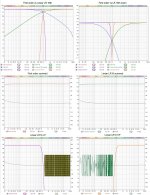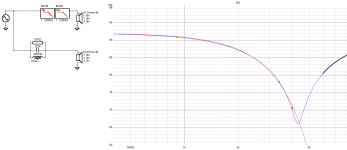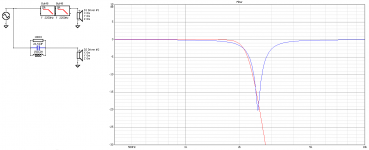Well put.Sure, you can use these filters. They will not sound like garbage. But at the most discerning level they will have a flaw, and if you have a very good system it might stand out and ruin what otherwise might be something excellent..
 A lot of things are like this, the fix will work, but may create new problems that are worse than what you are trying to cure.
A lot of things are like this, the fix will work, but may create new problems that are worse than what you are trying to cure.I'm going to ask a stupid question (sorry!) On my MEH project the mids have a natural 6th order highpass around 250Hz. Does the pre ringing apply to purely acoustic slopes or is it an 'electrical' thing ? I was going to match the slope on my basshorn with a 6th order highpass. Am I better (sound quality wise) to use EQ to achieve a 4th order acoustic crossover? (flatten the slope below the mids xo for 2 octaves with EQ then apply 4th order electrical slopes)
Sorry for the hijack 😱
Rob.
Sorry for the hijack 😱
Rob.
Last edited:
I see many active crossovers or DSP now use filter beyond 4th order popularly. Is it a good idea to go beyond 4th order filter on passive crossover network? Does anyone has any experience on this?
With DSP you can be "totally" accurate, but with actual crossover components, whether passive crossover at the drivers, or old-fashioned active before the amps using op-amp filters, higher order filters need higher precision components, else you'll get unacceptable peaks and dips in frequency response.Could anyone please inform the advantages and disadvantages of using higher orders above 4th order?
Inductors and capacitors with 1% tolerance are expensive if you can find them, so much that it can be cheaper to buy a bunch of 5% or 20% parts and measure their exact values (with a good LRC meter, under $100 thesedays), pick the closest and/or combine several parts in series/parallel to get close enough to the values you need.
I'm going to ask a stupid question (sorry!) On my MEH project the mids have a natural 6th order highpass around 250Hz. Does the pre ringing apply to purely acoustic slopes or is it an 'electrical' thing ? I was going to match the slope on my basshorn with a 6th order highpass. Am I better (sound quality wise) to use EQ to achieve a 4th order acoustic crossover? (flatten the slope below the mids xo for 2 octaves with EQ then apply 4th order electrical slopes)
Sorry for the hijack 😱
Rob.
Hi Rob, here's my 2c.
If you are using anything but FIR, I don't think pre-ringing is ever an issue...iow, not only is it an electrical thing, it's a FIR electrical thing.
(And frankly, a way over-ballyhooed thing.
Ime, you simply have to be using FIR to make corrections that are too strong, point in space specific, or trying to correct the things that can't be fixed...for pre-ringing to be at all audible.)
If i remember right, your MEH is either passive or active IIR...so all you have to worry about is post-ringing (that's meant to be a half joke 😉).
As IIR xovers are not minimum phase and their impulse response tails, and group delays do get longer as order increases.
Driver's acoustic rolloffs before xover are supposed to be mainly minimum phase, so they can be altered via minimum phase, and remain minimum phase. No harm done at all from an impulse or phase point of view.
I'm taking you meant match the slope of the basshorn with the right order lowpass .
Personally, I like your suggestion to flatten the mids by 2 orders, and then sum to the basshorn 4th order.
But of course, that's providing the mids can take the somewhat increased excursion through xover region. That's the only potential harm from adding the minimum phase flattening that I know of...
Hope that all made sense...
Thanks Mark,
I've got to admit I thought pre ringing was mentioned in this thread somewhere, but I can't find it now 😀 (When I get home from work I open multiple tabs of diyaudio and 'catch up' while cooking dinner so I may have got confused between threads regarding pre ringing and group delay peaking) I even opened my mids measurement to check its impulse response !??
Anyhow yes I did mean lowpass for the basshorn, and I'm using 4 mids per horn so they should take a little EQ in the low end (home use only and 2 mids were plenty loud enough ) My basshorns are flat to 500Hz so I could move the xo point up a little to ease the amount of boost on the mids if needed.
Cheers,
Rob.
I've got to admit I thought pre ringing was mentioned in this thread somewhere, but I can't find it now 😀 (When I get home from work I open multiple tabs of diyaudio and 'catch up' while cooking dinner so I may have got confused between threads regarding pre ringing and group delay peaking) I even opened my mids measurement to check its impulse response !??
Anyhow yes I did mean lowpass for the basshorn, and I'm using 4 mids per horn so they should take a little EQ in the low end (home use only and 2 mids were plenty loud enough ) My basshorns are flat to 500Hz so I could move the xo point up a little to ease the amount of boost on the mids if needed.
Cheers,
Rob.
Rob do you have a thread on your speakers here somewhere? I'll go look,,,,
EDIT: Found it. Looks just like your avatar. 🙂
EDIT: Found it. Looks just like your avatar. 🙂
Mark, I try to keep an open mind but when I see statements likemark100 said:trying to find ways to rationalize my beliefs...
..I see no handle, I can't tell whether you're speculating or claiming so all I can say is I disagree, prove it.I typically use complementary 16th order, as it invariably improves polars, and achieves time domain response equal to first order.
Because he mentioned 16th order behaving like a 1st order in the time domain I was assuming that he uses a liear phase FIR approximation with the amplitude respponse of a 16th order analog filter. Simply because it made sense to me. These no-too-steep FIR filters have the advantage of less pre-ringing than almost brick-wall types.
Regards
Charles
Regards
Charles
Last edited:
Mark, I try to keep an open mind but when I see statements like
..I see no handle, I can't tell whether you're speculating or claiming so all I can say is I disagree, prove it.
Allen, I must object to your post for two reasons.
You pulled my quotes from two different threads, which removes them from their context. Not cool unless you are trying to point out clearly conflicting statements, and make it known that's what you're doing.
First quote being: "trying to find ways to rationalize my beliefs..."
And you truncated the second quote to "I typically use complementary 16th order, as it invariably improves polars, and achieves time domain response equal to first order."
...saying you can't tell whether I'm speculating or claiming.
My full post you pulled that from was:
I like as low an order that works, for either active or passive, for better time domain response.
Unless the active is FIR linear phase xovers.
Then, I typically use complementary 16th order, as it invariably improves polars, and achieves time domain response equal to first order.
I would say there is plenty of "handle" there...now in bold if you missed it.
There was no mention of speculation in that post. Truncation not cool.
So those objections aside, yes it's a claim, not speculation.
I would think the fact that complementary linear phase xovers have first order, that is flat phase summation, goes without question. ????
But anyway, attached is a chart showing IIR BW 6dB/oct first order vs linear phase LR 96dB/oct 16th order.
Top two are comparative magnitude traces for summed, LP,and HP... and the same zoomed in.
Middle two are mag and phase for LP and HP summed.
Bottom two are for the phase traces of the linear phase LP and HP, just for additional illustration.
These are measurements. I used an un-calibrated sound card so even the small phase variations of the sound card are shown to be identical.
As far as improved polars, I have made many measurements, that have proven to me that the ability to narrow the range of frequency overlap, reduces the extent of lobing. As per the chart's top right mag zoom-in.
The second benefit to polars is that complementary linear phase xovers allow the xover frequency to be moved up or down to help match horiz and vert radiation patterns, all the while maintaining flat mag and phase on axis. (This assumes pre-xover minimum phase mag flattening was applied to the drivers.)
It's the easiest way I've found so far, of trying to find best xover freq for polars....which is the most daunting task in speaker tuning i think.
Attachments
Because he mentioned 16th order behaving like a 1st order in the time domain I was assuming that he uses a liear phase FIR approximation with the amplitude respponse of a 16th order analog filter. Simply because it made sense to me. These no-too-steep FIR filters have the advantage of less pre-ringing than almost brick-wall types.
Regards
Charles
Thanks Charles,
Glad it made sense to you at least.
And good point vs brick-wall. That's another reason i use not-too-steep 16th.
Indeed sometimes, but certainly not invariably.invariably improves polars
So I think of the case where you are trying to join together two drivers to make a system. You have the woofer directivity, the tweeter, and what happens when they overlap. You have rates changing where they would be easier if constant, you have patterns changing with frequency in a disorganised way. You have compromised horns due to the size constraints, along with their anomalies.
What you have described is specific to one part, the overlap, except the individual contributions to the overlap. It would reduce but not eliminate the region of that issue. There is much to be considered afterward in the design process to optimise that cross, that will alter the outcome.
Which would be against the rules (misquoting to gain advantage), but quoting across threads is OK if done with good intentions (and preferrably on topic).You pulled my quotes from two different threads, which removes them from their context. Not cool
....
truncation
I meant no confusion. I was going to split this reply across the two threads but you seemed to have your hands full on the other thread at the time.
Others should know that traditional filters will also slide up and down and will match in phase as they do.. but no filter can make horizontal and vertical match at the same time when the shape isn't correct.The second benefit to polars is that complementary linear phase xovers allow the xover frequency to be moved up or down to help match horiz and vert radiation patterns,
I wonder how much room you'd need to build a passive 16th order crossover? 😱Is it a good idea to go beyond 4th order filter on passive crossover network?
Hmmm. So maybe not has bad as I feared. Your symbols didn't print, are the mH, ohm and milli-ohm?
- Home
- Loudspeakers
- Multi-Way
- Going beyond Fourth order...


